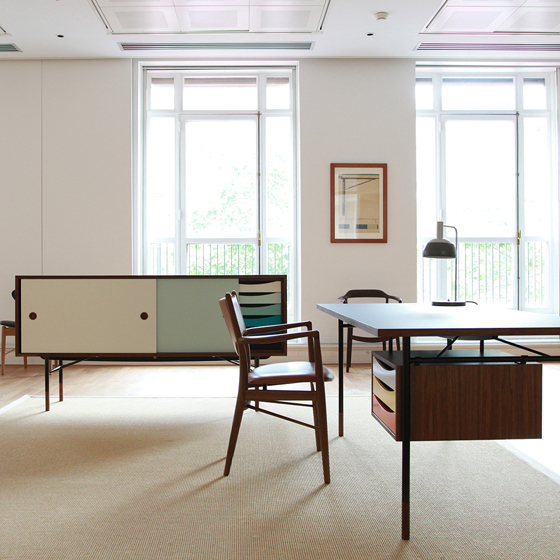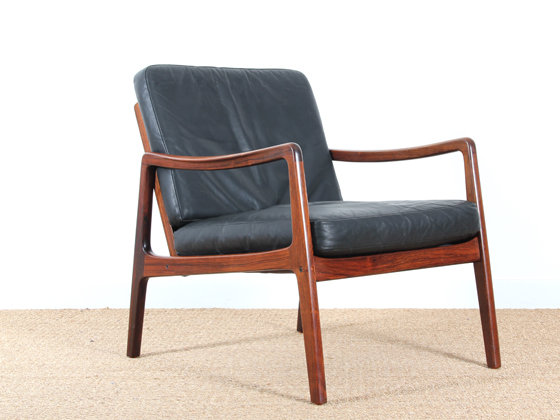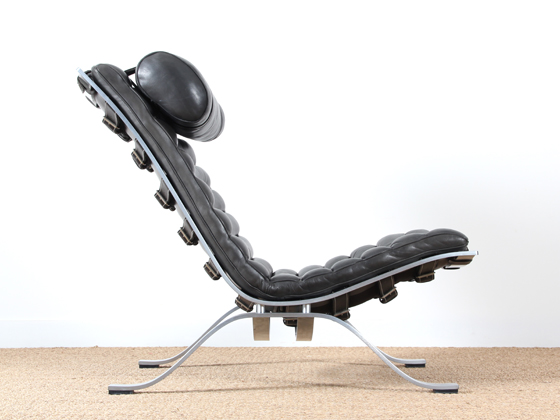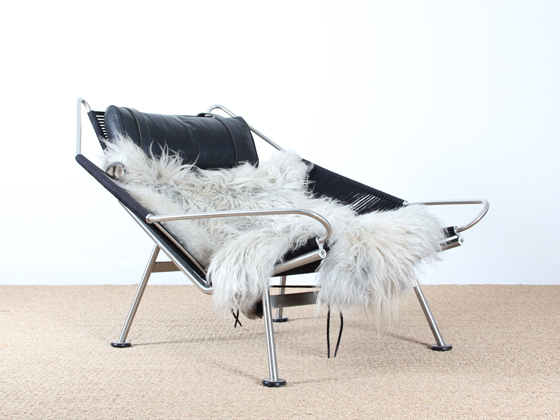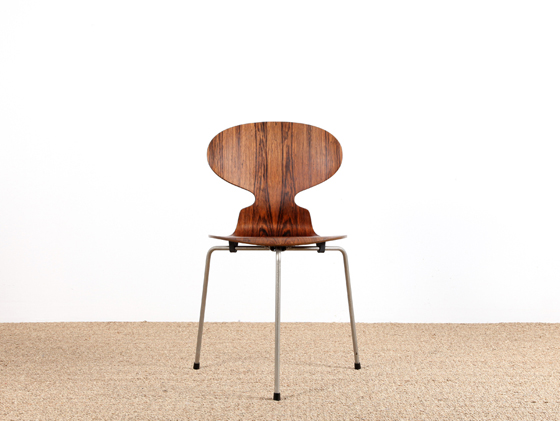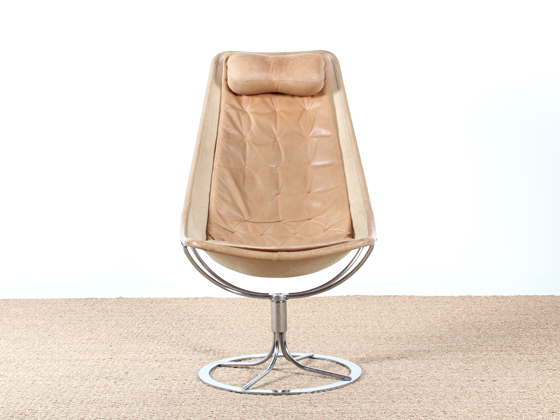Vintage Scandinavian furniture
Text by TLmag
Brussels, Belgium
28.01.15
It’s a real phenomenon, an undeniable success. How did designers from different countries who share common values, manage to create a style more than sixty years ago, that retains a remarkably modernist appeal, and continues to fuel the demand for reissued furniture?
This movement originated in the 1920s in Scandinavia, which comprises Denmark, Norway and Sweden, to which for the purposes of this article we can add Finland and Iceland. There was a climate of creative effervescence in Europe. In 1918, Le Corbusier’s collaboration with Cubist painter Amédée Ozenfant resulted in the publication of “After Cubism” and in Germany, in 1919, Walter Gropius created the Bauhaus based on a minimalist concept that was in sharp contrast to the flamboyance of Art Deco.
Between the cool pure forms of the Bauhaus and the warm, sophisticated polychrome designs of the 1930s, Scandinavian art appeared as the synthesis of something truly original. The first movement retained the purity of lines and volumes, the second the warmth and refined materials – sophistication without ostentation. But, if these influences were felt on an aesthetic level, the values that underpin them are very specific. They belong to a school of thought that first manifested in Sweden, where essayist Ellen Key had caused a sensation in 1899, with a pamphlet she had published entitled Skonhert for Alla (Beauty for All).
However, we would have to wait until Gregor Paulsson had written Vaackarare Vardagsvara (More Beautiful Things for Everyday Use) before any serious reflection around a new philosophy of furniture took place. Paulson, a historian and sociologist, advocated collaboration between artists and manufacturers. In fact he might be considered to have contributed to asserting the very identity of the “designer.”
The rigour and simplicity of Scandinavian design
In these Nordic countries, where the climate is rude and days are short, where light is rare but sublime, the home is a place of life, a refuge. It is therefore necessary to optimise the characteristics of the habitat. The fundamental design criteria for Scandinavian design was quickly defined: functional, solid, high quality, easy to use, well proportioned, easy to integrate, unadorned, simple, pure lines, and always beautiful. This beauty is expressed in many ways, in the careful selection of materials and their processing.
The creation of beautiful everyday forms
Parallel to this, in Denmark in the 1920s – spurred on by Poul Henningsen (1894-1967), editor of Kritisk Revey (Critical Review) and a leading figure in Scandinavian design – the emphasis was put firmly on the moral duties of designers, who had to take into account people’s quality of life whilst reflecting on the need to provide them with pieces of furniture that were objects in their own right, and contributed to the appeal of interiors.
The creation in 1924 of the Furniture Department within the School of Architecture at the Royal Danish Academy of Fine Arts along with groundbreaking teaching methods practised by the charismatic architect and designer Kaare Klint (1888-1954) also had a strong impact. Klint introduced the concept of ergonomics to enhance comfort. He also advocated the harmonisation of decorative elements accompanying furniture, and launched the concept of modular elements that inspired Cadovius to design his wall system that could be extended or reconfigured as desired, which set a benchmark for wall storage design.
The essential materials
Wood is the predominant material. Beautifully worked, curved, bent, magnified, it is the noble material par excellence: exotic woods such as teak or rosewood are carefully worked to bring out the beauty of the grain, the colours, the patina, before the addition of fine elegant hinges, or small locks with delicately forged keys.
The finishes are always perfect: fine mitre cuts, precise mortise and tenon joints, moulded hollow handles. There are also wood veneers made from birch, pine, sycamore for a secretaire and cabinets, lemonwood for simple free flowing interiors. Oak and beech are also used in plywood. They can also be combined with materials such as leather, stone, marble or glass. Like wood, these materials are derived from nature, which is never far away.
Steel and aluminium are also two very characteristic materials. Steel, a material used in large quantities by the designer Arne Jacobsen, can be chromed, lacquered or silvered. As for aluminium, Louis Poulsen was probably responsible for raising the profile of this material with his famous PH lamps. Finally, the use of new materials such as imitation leather, moleskin, resin or polyurethane foam frames, reflect the modernity of the movement.
20th Century Scandinavian design icons
Of the five Scandinavian countries, Denmark is where you will find the greatest number of iconic designers: Arne Jacobsen (1902-1971) designed his “Ant” chair for the canteen at Danish pharmaceutical firm Novo. The seat and backrest were moulded from the same single sheet of plywood, which was a first. This inspired the “Series 7” range and the “3107” which became one of the greatest selling pieces of furniture ever designed: 5 million units have been sold to date. For the refurbishment of the SAS Royal Hotel in Copenhagen in 1958, the first skyscraper to grace Denmark, he created two pieces of furniture that have become absolute icons: the “Swan” chair with extended armrests and the brilliant curvaceous “Egg” chair. Much copied, it is THE benchmark for Scandinavian design.
Ole Wanscher (1903-1985) is associated with delicate, elegant and orderly forms that were often made by the master cabinetmaker A.J. Iversen. Wanscher often drew inspiration from Egypt’s decorative arts (the famous eponymous “Egyptian” stool) and from England and China.
Finn Juhl (1912-1989) was one of the first Danish designers to receive international recognition. Self-taught, he designed unusual, sculptural and expressive pieces, which put more emphasis on form than function: the “45” chair and “Chieftain” chair are two of his most well-known pieces.
In Finland, two designers that immediately spring to mind are Alvar (1898-1976) & Aine Aalto (1894-1949). Alvar’s material of choice was plywood, which he glued and bent during his experimentations which led to the creation of a series of highly innovative chairs, “no 41” and “no 31,” (1931-1932). His new techniques for bending and splicing wood allowed the leg pieces to be attached to the underside of the seat without the need for a frame or extra support, which was a first. In 1933, Aalto designed a series of stands for chairs that made use of this technology: “L-leg” (1932-1933) was followed by “Y-leg” (1946-1947) and “Fan-leg” (1954) which was used on the stackable “no 60” stool. Often referred to as a “pioneer of organic design”, he greatly influenced post-war designers like Charles & Ray Eames.
In Sweden, Bruno Mathsson (1907-1988) is one of the first names that comes to mind. His ideas were coloured by functionalism, and not only did he prove to be an excellent cabinetmaker, using a special technique to bend wood, but also distinguished himself through his ergonomic research to discover the “ultimate seating”. This led to the creation of his “Pernilla” chair and the “Jetson” chair.
Arne Norell (1917-1971) who created the “Ari” chair is the other big name in Swedish design. And no Scandinavian house can be complete without some of the excellent ceramic and glass products designed by the many other designers. Orrefors, associated with unique glassware in Sweden, were the first to invite artists such as Simon Gate and Edvin Hald to create for them. Then there’s the collaboration between Danish designer Per Lutkend and the glassworks at Holmegaard. Or the working relationship of Gunnar Nylund and Carl-Harry Stålhane, famous potters inspired by the ceramics of the Chinese Song Dynasty, and of course there’s Stig Lindberg and his famous “Bersa” motif.
Hans J. Wegner (1914-2007) produced high quality and thoughtful work. This year marks the centenary of his birth. Renowned for his chairs, he was once an assistant to Arne Jacobsen and Erik Moeller. In 1943, he founded his own design studio and created the “China Chair” (which later became “The Chair” produced by Fritz Hansen), which would bring him his first taste of commercial success. His creations are revered for their flowing solid lines and their sophistication, devoid of ostentation: the “Peacock” chair (1947) the “Shell” chair (1948) “Wishbone” or “Y” chair (1949); the amusing “Flag Halyard” chair (1950) in real sheepskin – the original version was presented with wooden clogs. However “The Chair” remains his most emblematic creation. As a matter of interest, John Kennedy, who suffered from backache, chose this chair for his televised debate with Richard Nixon in 1960.
The art market is rising
In recent years, the success of Scandinavian design, from furniture to lighting and ceramics, is undeniable. Reissued furniture (Design-ikonik, Danish boutiques, etc.) is multiplying, sales are buoyant at auction (Pierre Bergé in Brussels, Piasa Rive Gauche and Artcurial in Paris), new shops are appearing, and almost every stand at the flea market has a piece to sell, even if it has been badly touched up!
Trend, fad, or is there genuine interest? The recent widespread awakening of environmental consciousness, saturation of disposable products and hyper-consumerism suggests that it’s here to stay, particularly as these timeless designs, with their pure lines, warm materials, discreet elegance and comfortable solidity, are in perfect harmony with the times.

